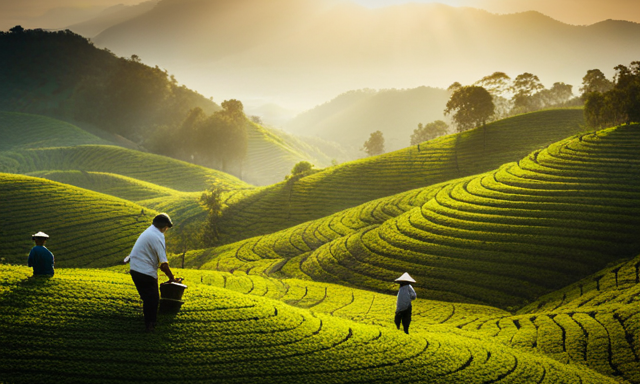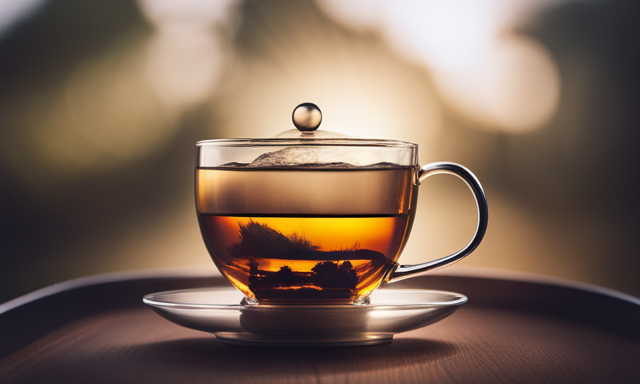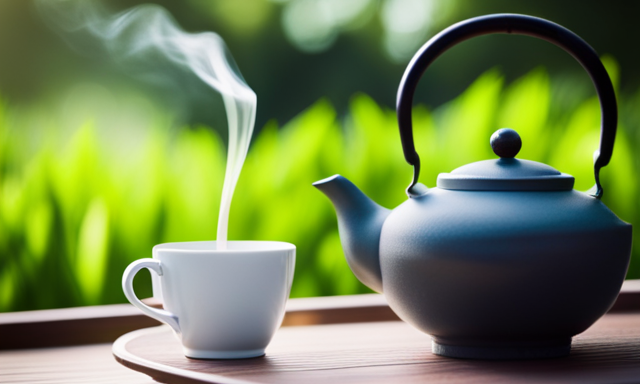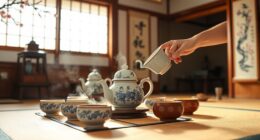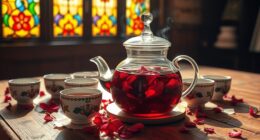Are you tired of the same old beverages and looking for a refreshing twist? Look no further, because I have the perfect solution for you: homemade iced oolong tea!
In this article, I will guide you through the simple steps to create a delicious and cooling drink that will leave you feeling rejuvenated.
First and foremost, gather your ingredients and equipment. Boil some water and steep the oolong tea leaves to extract that rich, flavorful essence. Once you’ve strained the tea leaves and let it cool, it’s time to prepare some ice cubes. You can also add a sweetener of your choice for a touch of sweetness.
Now comes the fun part – fill a glass with ice cubes and pour the cooled tea over it. Watch as the icy cubes mix with the aromatic tea, creating a delightful and invigorating combination.
To add a final touch, garnish your iced oolong tea with a slice of lemon or a sprig of mint.
So sit back, relax, and enjoy your homemade iced oolong tea! It’s the perfect companion for a sunny day or a relaxing evening. Cheers to a refreshing sip that will awaken your senses!
Key Takeaways
- Iced oolong tea offers numerous health benefits, including boosting metabolism, aiding in weight loss, improving heart health, and providing antioxidants.
- There are various garnish ideas for iced oolong tea, such as fresh mint sprig, lemon or lime twist, slices of cucumber, berries, and edible flowers.
- To enhance the flavor of iced oolong tea, you can experiment with different sweeteners, add citrus for a tangy twist, infuse with fruits, herbs, or spices, consider adding vanilla ice cream, or mix with alcohol and fresh fruit or herbs for a cocktail.
- Homemade iced tea, including oolong tea, is packed with antioxidants, improves digestion, boosts metabolism, supports weight management, and promotes heart health.
Gather Your Ingredients and Equipment
Now that you’ve got everything ready, it’s time to start brewing your refreshing iced oolong tea.
First, let’s talk about choosing the right type of oolong tea. There are various varieties available, such as light and floral, or rich and roasted. Consider your personal preference and the flavor profile you desire.
Next, think about the different types of sweeteners you can use. Traditional options include honey, sugar, or simple syrup, but you can also experiment with alternatives like agave or stevia.
Once you’ve decided on your oolong tea and sweetener, it’s time to move on to the next step. Boil water and steep the oolong tea leaves to release the desired flavors.
Boil Water and Steep Oolong Tea Leaves
First, heat up some water and let the oolong tea leaves steep to perfection.
To achieve the best flavor, steep the leaves for the right amount of time and at the appropriate water temperature. Oolong tea leaves are delicate, so steeping them for too long or at too high a temperature can result in a bitter taste.
I recommend bringing the water to a boil and then allowing it to cool for a minute or two before pouring it over the tea leaves. This will ensure that the water is at the optimal temperature of around 180-200°F (82-93°C).
Let the tea leaves steep in the hot water for about 3-5 minutes to extract their full flavor.
Once the steeping time is up, strain the tea leaves and let the tea cool.
Strain the Tea Leaves and Let the Tea Cool
After allowing the oolong tea leaves to steep to perfection, it’s time to strain them and let the tea cool, allowing its flavors to bloom like a delicate flower.
Straining techniques are crucial to ensure a smooth, sediment-free tea. One option is to use a fine-mesh strainer, which effectively removes any loose tea leaves. Another method is to pour the tea through a cheesecloth-lined sieve, which provides an even finer filtration.
Once strained, it’s important to let the tea cool to the ideal temperature. This usually takes around 30 minutes, but it can vary depending on personal preference. Some tea connoisseurs prefer to refrigerate the tea for a refreshing, chilled experience.
Now that the tea is perfectly strained and cooling, let’s move on to the next step: preparing ice cubes to create a wonderfully refreshing iced oolong tea.
Prepare Ice Cubes
To ensure a truly refreshing experience, you’ll want to get those ice cubes ready. Here are some ideas for discussion:
-
Different flavor variations for iced oolong tea: You can add a splash of fruit juice like lemon or peach for a tangy twist, or try infusing the tea with fresh herbs like mint or basil for a herbaceous flavor profile.
-
How to make decorative ice cubes for your iced oolong tea: Get creative and freeze fresh fruit slices, edible flowers, or even tea leaves in your ice cubes. This adds visual appeal and adds a subtle hint of flavor as the ice melts.
-
Don’t forget to keep some plain ice cubes on hand as well, especially if you prefer your tea unsweetened. They’ll help keep your drink cool without diluting the flavor too much.
-
If you’re feeling adventurous, try experimenting with different tea blends or adding a splash of sparkling water for a bubbly twist.
Now that your ice cubes are ready, let’s move on to the next step: choosing your sweetener (optional).
Choose Your Sweetener (Optional)
Once you have prepared your ice cubes, it’s time to decide whether you want to add a touch of sweetness to your refreshing beverage. When it comes to sweetening your iced oolong tea, there are various options to consider.
Some popular choices include honey, agave syrup, or traditional white sugar. Each sweetener brings its own unique flavor profile to the tea, so it’s worth experimenting to find your preferred taste. However, it’s important to keep in mind that adding sweeteners can affect the health benefits of the tea. While they enhance the flavor, they also increase the calorie content.
So, if you’re watching your sugar intake, you might want to opt for a sugar-free alternative. Ultimately, the choice of sweetener is up to personal preference and dietary considerations.
Now, let’s move on to the next step of adding sweetener and stirring until dissolved.
Add Sweetener and Stir Until Dissolved
Enhance the flavors of your refreshing beverage by adding your preferred sweetener and stirring until fully dissolved.
When it comes to sweetening your iced oolong tea, there are various options to choose from. Traditional white sugar is a popular choice, but if you’re looking for alternative sweeteners, you can try using honey, agave syrup, or stevia. These options offer a different flavor profile and can be adjusted to your desired level of sweetness.
Add your chosen sweetener to the pitcher of brewed oolong tea and stir until fully dissolved. This allows the sweetener to blend evenly throughout the tea, ensuring a consistent taste in every sip.
Once dissolved, you can move on to the next step of filling a glass with ice cubes, which will help to chill the tea and create a refreshing beverage.
Fill a Glass with Ice Cubes
Grab a glass from the cupboard, because what comes next will cool you down in the most satisfying way. Before we pour the cooled tea over the ice, let’s take a moment to discuss the different types of iced tea variations and the benefits of drinking iced oolong tea in the summer.
Iced tea is a refreshing beverage enjoyed worldwide, with various flavors and preparations. From classic black tea to fruity herbal blends, there’s a type of iced tea to suit every taste. However, oolong tea stands out for its unique flavor profile, which ranges from floral to nutty, making it a perfect choice for a refreshing summer drink.
Drinking iced oolong tea in the summer brings numerous benefits. It not only quenches your thirst but also provides a natural boost of energy due to its moderate caffeine content. Oolong tea is also known for its potential health benefits, such as promoting digestion, supporting weight management, and providing antioxidants.
Now that we understand the different types of iced tea and the benefits of oolong tea, let’s move on to the next step: pouring the cooled tea over the ice.
Pour the Cooled Tea Over the Ice
Now, cool off and experience pure refreshment by pouring the chilled tea over those glistening ice cubes in your glass. As you savor the icy sensation, let’s discuss some exciting ideas for enjoying iced oolong tea:
- Try adding a squeeze of lemon or a splash of fruit juice for a burst of flavor.
- Experiment with different sweeteners like honey or agave syrup to find your perfect balance of sweetness.
- Get creative with garnishes such as mint leaves, sliced fruit, or even edible flowers to elevate the visual appeal of your iced oolong tea.
Not only does iced oolong tea taste fantastic, but it also offers numerous health benefits compared to other types of tea. With its high levels of antioxidants, oolong tea can boost your metabolism, aid in weight loss, and improve heart health.
Now that you have poured the cooled tea over the ice, let’s move on to the next section where we discuss how to garnish and serve this delightful beverage.
Garnish and Serve
To add a touch of elegance to your glass, delicately place a sprig of fresh mint on the rim and watch as it gracefully dances in the cool breeze. Garnishing your iced oolong tea not only adds visual appeal but also enhances the overall flavor profile. There are various garnish ideas you can experiment with to elevate your tea-drinking experience. Consider adding a twist of lemon or lime for a refreshing citrusy kick, or a few slices of fresh cucumber for a cool and crisp taste. You can also try dropping in a couple of berries, such as raspberries or blueberries, to add a hint of sweetness. Another option is to garnish with edible flowers like lavender or chamomile, which not only look beautiful but also impart a subtle floral aroma. Get creative and try different serving suggestions to find your favorite combination of flavors. Now, it’s time to enjoy your homemade iced oolong tea!
Enjoy Your Homemade Iced Oolong Tea!
Savor the delightful creation you’ve crafted and indulge in the refreshing goodness of your homemade iced oolong tea! Here are some reasons why homemade iced tea is beneficial and different ways to enjoy it:
-
Health Benefits: Homemade iced oolong tea is packed with antioxidants that promote overall well-being. It helps improve digestion, boosts metabolism, and supports weight management.
-
Customize Your Flavor: Experiment with different sweeteners like honey or agave, or add a splash of citrus for a tangy twist. You can also infuse your tea with fruits, herbs, or spices to create unique flavor combinations.
-
Ice Cream Float: Pour your homemade iced oolong tea over a scoop of vanilla ice cream for a decadent treat that combines the rich creaminess of ice cream with the refreshing taste of tea.
-
Tea Cocktails: Get creative and mix your homemade iced oolong tea with a splash of vodka or gin, and add some fresh fruit or herbs for a refreshing adult beverage.
Enjoy the versatility and goodness of your homemade iced oolong tea in these different ways!
Frequently Asked Questions
How long should I steep the oolong tea leaves for?
I’ll steep the oolong tea leaves for about 3-5 minutes. Steeping time variations can depend on personal preference and the desired strength. It’s important to use water at the best temperature for steeping, around 195-205°F, to extract the tea’s flavors effectively.
Can I use any type of sweetener for my iced oolong tea?
You can use different types of sweeteners for your iced oolong tea. Some of the best options include honey, agave syrup, or stevia. These sweeteners add a touch of sweetness without overpowering the flavor of the tea.
Is it necessary to strain the tea leaves before letting the tea cool?
Yes, it is necessary to strain the tea leaves before letting the tea cool. Using a tea strainer has benefits like removing sediment and enhancing the taste. Alternative methods include using a French press or cold brewing.
How many ice cubes should I use for each glass of iced oolong tea?
For each glass of iced oolong tea, I recommend using around 3-4 ice cubes. This will help to keep the tea cold without diluting the flavor too much. Experiment with flavored or fruit infused ice cubes for added taste.
Are there any specific garnishes that pair well with iced oolong tea?
There are several garnish options that pair well with iced oolong tea. Some popular choices include fresh mint leaves, lemon slices, or even a sprig of lavender. These garnishes add a burst of flavor and enhance the overall experience of the tea.
Conclusion
In conclusion, making iced oolong tea is a simple and refreshing process that anyone can do at home. With just a few ingredients and some patience, you can create a delicious and cooling beverage that will leave you feeling rejuvenated.
So why wait? Dive into the world of iced oolong tea and experience the ultimate thirst-quencher that will transport you to a tropical paradise with just one sip. Trust me, it’s like a taste of heaven in a glass!


